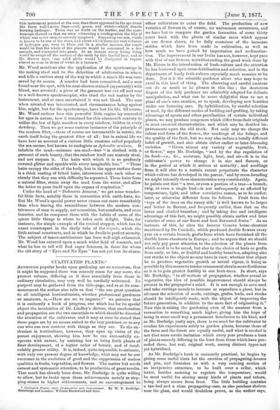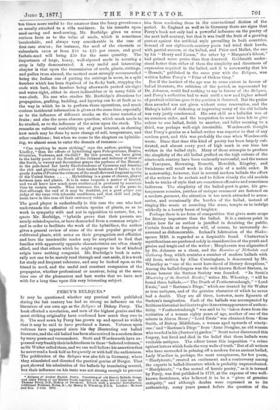CULTIVATED PLANTS
ALTHOUGH popular books upon gardening are so numerous, that it might be supposed there was scarcely room for any more, the present volume, differing as it does essentially from those in ordinary circulation, may very well be cordially welcomed. Its purport may be gathered from the title-page, and as at its com- mencement the author also tells us that " the one great question to all intelligent horticulturists, whether professional gardeners or amateurs, is,—How are we to improve ?" we perceive that it is eminently a book of progress, one which has for its special object the inculcation of Dr. Lindley's dictum, that amelioration and propagation are the two essentials to which should be directed the attention of the cultivator, and it may at once be stated that these pages are by no means suited to the lazy gardener, or to any one who can rest content with things as they are. To the en- thusiast in horticulture, however, they open up vistas of the purest enjoyment, showing him how he can successfully co- -operate with nature, by assisting her to bring forth plants of finer development, of a higher order of beauty, and of incal- culably greater utility. It is, indeed, quite impossible to estimate, with only our present degree of knowledge, what may not be our successes in the evolution of good and the suppression of useless qualities in fruits, vegetables, and flowers. The matter but needs earnest and systematic attention, to be productive of great results. That much has already been done, Mr. Burbidge is quite willing to allow, but he looks upon these achievements merely as step- ping-stones to higher achievements, and an encouragement to Cultivated Plants: their Propagation and Improvement. By W. T. Burbidge. Edinburgh and London: William Blackwood and Bona.
other cultivators to enter the field. The production of new varieties of flowers is, of course, no uncommon occurrence, and we have but to compare the garden favourites of some thirty years back with the plants of similar races which appear at our flower shows, to be fully conscious of the immense strides which have been made in cultivation, as well as how much we have gained by importation and acclimatisa- tion. The improvement in our fruits has not, however, kept pace- with that of our flowers, notwithstanding the good work done by Mr. Rivers in the introduction of bush-culture and the attention he has bestowed upon cross-fertilisation and selection, and in the department of hardy fruit-culture especially much remains to be done: Nor is it the scientific gardener alone who may hope to excel in this kind of tiling. The observing and careful amateur can do as much as be pleases in this line ; the dexterous fingers of the lady gardener are admirably adapted for delicate manipulation, and what can be more delightful than to see a plant of one's own creation, so to speak, developing new beauties under our fostering care. By hybridisation, by careful selection of seed, by the different modes of budding and grafting, by taking advantage of sports and other peculiarities of certain individual plants, we may produce congeners which differ from their originals in most essential characteristics, and which may be decided im- provements upon the old stock. Not only may we change the colour and form of the flower, the markings of the foliage, and the quality of the fruit, but we may also induce a totally different habit of growth, and also obtain either earlier or later-blooming
varieties. " Given almost any variety of vegetable, fruit, or flower," says Mr. Burbidge, "and by the due regulation of its food—i.e., &c., moisture, light, heat, and air—it is in the cultivator's power to change it in size and flavour, or in the period at which it arrives at maturity ; and seedlings from it will also to a certain extent perpetuate the character which culture has developed in the parent," and by cross-breeding we might intensify these characteristics very considerably. Again, he points out that " a tree, or even a portion of a tree—a branch, twig, or even a single bud—is not unfrequently so affected by temperature, light, and other correlative causes, as to be earlier, later, or otherwise different from its fellows. Fruit from the 'tops of the trees on the sunny side' is well known to be larger and better in flavour, and frequently earlier, than that on the lower and shaded branches ; and by taking due and intelligent advantage of this fact, we might possibly obtain earlier and later varieties of some of our finest and best-flavoured fruits." As an instance of this, he cites the famous Geneva horse-chestnut mentioned by De Candolle, which produced double flowers every year on a certain branch, grafts from which have furnished all the double horse-chestnuts in Europe ; and he argues that we should not only pay great attention to the selection of the plants from which seed is to be saved, but also to the choice of buds or grafts, from early, or late, or fruitful and healthy branches, adapting also our stocks to the object we may have in view, whether that object be to produce vegetative growth or sexual vigour, it being as possible by this means to render ornamental shrubs more floriferous as it is to gain greater fertility in our fruit-trees. In short, says Mr. Burbidge, " in all matters of propagation, whether sexual or vegetative, the idea of possible improvement should always be present in the propagator's mind. It is not enough to save seed and take cuttings merely to increase or reproduce a plant, but in all cases the selection of seeds, cuttings, grafts, bads, and stocks should be intelligently made, with the object of improving the future generation, in addition to the mere fact of originating it." Now this is raising the gardening even of the amateur from a recreation to something much higher, giving him the hope of being in some small way a permanent benefactor to his kind, and as Mr. Burbidge justly says, there is no need for the cultivator to confine his experiments solely to garden plants, because those of the farm and the forest are equally useful, and what is needed is not that mere servile imitation which every year produces a host of plants scarcely differing in the least from those which have pre- ceded them, but real, original work, among distinct types not yet hybridised.
As Mr. Burbidge's book is eminently practical, he begins by giving some useful hints for the erection of propagating-houses and pits, and furnishes us with a very enticing section of an inexpensive structure, to be built over a cellar, which latter, besides assisting to regulate the temperature, would be most useful for storing many kinds of plants and tubers, being always secure from frost. The little building contains a tan-bed and a close propagating-case, as also pendant shelves near the glass, and would doubtless prove, as the author says,
ten times more useful to the amateur than the fancy greenhouses so usually attached to a villa residence. In his remarks upon seed-saving and seed-sowing, Mr. Burbidge gives us some curious facts as to the value of seeds, which is sometimes incalculable, and always very considerable in the case of first-rate stra;ns ; for instance, the seed of the cineraria or valceolaria rates at from £10 to £15 per ounce, and good fuchsia-seed will bring £50 for the same quantity. The importance of large, heavy, well-ripened seeds in securing a crop is fully demonstrated. A very useful and interesting chapter is that upon the transmission of seeds, plants, cuttings, and pollen from abroad, the method most strongly recommended being the Indian one of putting the cuttings in moss, in a split bamboo which has been deprived of its fleshy bark, stopping the ends with bark, the bamboo being afterwards packed air-tight and water-tight, either in sheet indiarubber or in many folds of wax-cloth. No one who studies Mr. Burbidge's directions for propagation, grafting, budding, and layering can be at fault as to the way in which he is to perform those operations, and much curious incidental information is given at the same time, especially as to the influence of different stocks on the same varieties of fruits ; and also the more obscure question, which much needs to be studied, as to the influence of the scion upon the stock. The remarks on cultural variability are of great interest; as showing how much may be done by mere change of soil, temperature, and other conditions ; but when we come to the chapters on hybridis- ing, we almost seem to enter the domain of romance :—
"Can anything be more striking," says the author, quoting from " than the effects of hybridising upon Pelargoniums, Heaths, Gloxinias, Verbenas, and Glcdioii ? By this process, we have given to the hardy pears of the North all the richness and delicacy of those of the South, to watery and flavourless grapes the perfume of the Muscat ; to the pale-faced but hardy Rhododendrons of Caucasus and America the rich and glowing colours of their tender brethren of India ; to the -gaudy Azalea of Pontes the crimson of the small-flowered fragrant species
of the United States Hybridising is a game of chance, played between man and plants. It is in some respects a matter of hazard, and we all know how much more excitement is produced by uncertain than by certain results. What increases the charm of the game is, that although the end of it may be doubtful, yet a good player can judge of the issue with tolerable confidence, and that skill and judg- ment have in this case all their customary value."
The good player is undoubtedly in this ease the one who best understands the affinities of certain species of plants, so as to work in sympathy with and not in opposition to nature, for, to quote Mr. Burbidge, "hybrids prove that their parents are nearly-related species, or have descended from a common origin ;" and in order to facilitate the work of the hybridiser, the author gives a general review of some of the most popular groups of cultivated plants, with notes on their propagation and affinities. and here the unscientific reader may be surprised to find that families with apparently opposite characteristics are often closely allied, and that others which he might suppose to be of kindred origin have nothing congenial. Mr. Burbidge's book is natu- rally not one to be merely read through and cast aside, it is a work for study and frequent reference, and may be looked upon as the friend in need, and the useful and constant companion of the propagator, whether professional or amateur, being at the same time one of the pleasantest and beat works that we have met with for a long time upon this very interesting subject.



































 Previous page
Previous page